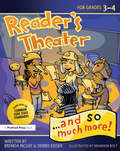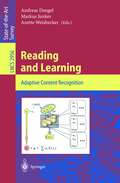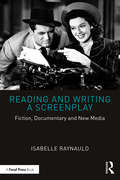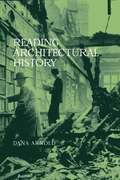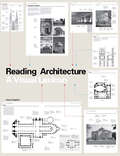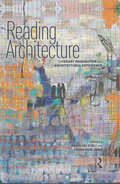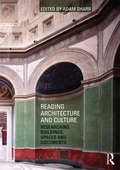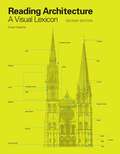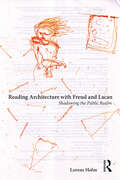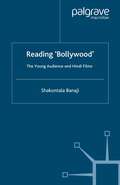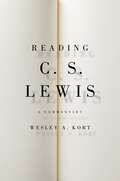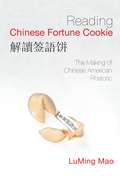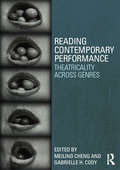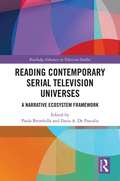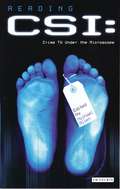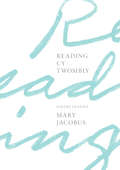- Table View
- List View
Reader's Theater...and So Much More!: Grades 3-4
by Brenda McGee Debbie Keiser TriskaReader's Theater . . . and So Much More! is written for grades 3-4. This exciting resource contains plays, skits, and independent research activities with an innovative twist for differentiated instruction. This high-interest book of humorous skits and plays is a jumping-off point for research and creativity for students of all ability levels. Each of the reader's theaters comes with suggestions for differentiating and extending the lesson's content. These plays not only provide a legitimate reason for students to reread texts and practice fluency, but they also promote cooperative interaction with peers.Grades 3-4
Reader's Theater...and So Much More!: Grades 3-4
by Brenda McGee Debbie Keiser TriskaReader's Theater . . . and So Much More! is written for grades 3-4. This exciting resource contains plays, skits, and independent research activities with an innovative twist for differentiated instruction. This high-interest book of humorous skits and plays is a jumping-off point for research and creativity for students of all ability levels. Each of the reader's theaters comes with suggestions for differentiating and extending the lesson's content. These plays not only provide a legitimate reason for students to reread texts and practice fluency, but they also promote cooperative interaction with peers.Grades 3-4
Reading and Learning: Adaptive Content Recognition (Lecture Notes in Computer Science #2956)
by Andreas Dengel Markus Junker Anette WeisbeckerThe amounts of information that are ?ooding people both at the workplace and in private life have increased dramatically in the past ten years. The number of paper documents doubles every four years, and the amount of information stored on all data carriers every six years. New knowledge, however, increases at a considerably lower rate. Possibilities for automatic content recognition in various media and for the processing of documents are therefore becoming more important every day. Especially in economic terms, the e?cient handling of information, i.e., ?- ing the right information at the right time, is an invaluable resource for any enterprise, but it is particularly important for small- and medium-sized ent- prises. The market for document management systems, which in Europe had a volume of approximately 5 billion euros in 2000, will increase considerably over the next few years. The BMBF recognized this development at an early stage. As early as in 1995, it pooled national capabilities in this ?eld in order to support research on the automatic processing of information within the framework of a large collaborative project (READ) involving both industrial companies and research centres. Evaluation of the results led to the conclusion that research work had been successful, and, in a second phase, funding was provided for the colla- rative follow-up project Adaptive READ from 1999 to 2003. The completion of thesetwoimportantlong-termresearchprojectshascontributedsubstantiallyto improving the possibilities of content recognition and processing of handwritten, printed and electronic documents.
Reading and Writing a Screenplay: Fiction, Documentary and New Media
by Isabelle RaynauldReading and Writing a Screenplay takes you on a journey through the many possible ways of writing, reading and imagining fiction and documentary projects for cinema, television and new media. It explores the critical role of a script as a document to be written and read with both future readers and the future film it will be giving life to in mind. The book explores the screenplay and the screenwriting process by approaching the film script in three different ways: how it is written, how it is read and how it can be rewritten. Combining contemporary screenwriting practices with historical and academic context, Isabelle Raynauld provides key analytical tools and reading strategies for conceptualizing and scripting projects based on the impact different writing styles can have on readers, with various examples ranging from early cinema to new media and new platforms throughout. This title offers an alternative, thought-provoking and inspiring approach to reading and writing a screenplay that is ideal for directors, producers, actors, students, aspiring screenwriters and readers interested in understanding how an effective screenplay is created.
Reading and Writing a Screenplay: Fiction, Documentary and New Media
by Isabelle RaynauldReading and Writing a Screenplay takes you on a journey through the many possible ways of writing, reading and imagining fiction and documentary projects for cinema, television and new media. It explores the critical role of a script as a document to be written and read with both future readers and the future film it will be giving life to in mind. The book explores the screenplay and the screenwriting process by approaching the film script in three different ways: how it is written, how it is read and how it can be rewritten. Combining contemporary screenwriting practices with historical and academic context, Isabelle Raynauld provides key analytical tools and reading strategies for conceptualizing and scripting projects based on the impact different writing styles can have on readers, with various examples ranging from early cinema to new media and new platforms throughout. This title offers an alternative, thought-provoking and inspiring approach to reading and writing a screenplay that is ideal for directors, producers, actors, students, aspiring screenwriters and readers interested in understanding how an effective screenplay is created.
Reading Architectural History
by Dana ArnoldArchitectural history is more than just the study of buildings. Architecture of the past and present remains an essential emblem of a distinctive social system and set of cultural values and as a result it has been the subject of study of a variety of disciplines. But what is architectural history and how should we read it?Reading Architectural History examines the historiographic and socio/cultural implications of the mapping of British architectural history with particular reference to eighteenth - and nineteenth-century Britain. Discursive essays consider a range of writings from biographical and social histories to visual surveys and guidebooks to examine the narrative structures of histories of architecture and their impact on perception adn understanding of the architecture of the past. Alongside this, each chapter cites canonical histories juxtaposed with a range of social and cultural theorists, to reveal that these writings are richer than we have perhaps recognised and that architectural production in this period can in interrogated in the same way as that from more recent past - and can be read in a variety of ways. The essays and texts combine to form an essential course reader for methods and critical approached to architectural history, and more generally as examples of the kind of evidence used in the formation of architectural histories, while also offering a thematic introduction to architecture in Britain and its social and cultural meaning.
Reading Architectural History
by Dana ArnoldArchitectural history is more than just the study of buildings. Architecture of the past and present remains an essential emblem of a distinctive social system and set of cultural values and as a result it has been the subject of study of a variety of disciplines. But what is architectural history and how should we read it?Reading Architectural History examines the historiographic and socio/cultural implications of the mapping of British architectural history with particular reference to eighteenth - and nineteenth-century Britain. Discursive essays consider a range of writings from biographical and social histories to visual surveys and guidebooks to examine the narrative structures of histories of architecture and their impact on perception adn understanding of the architecture of the past. Alongside this, each chapter cites canonical histories juxtaposed with a range of social and cultural theorists, to reveal that these writings are richer than we have perhaps recognised and that architectural production in this period can in interrogated in the same way as that from more recent past - and can be read in a variety of ways. The essays and texts combine to form an essential course reader for methods and critical approached to architectural history, and more generally as examples of the kind of evidence used in the formation of architectural histories, while also offering a thematic introduction to architecture in Britain and its social and cultural meaning.
Reading Architecture: A Visual Lexicon
by Owen HopkinsThis innovative and unique book is a visual guide to the buildings that surround us, naming all the visible architectural features so that, unlike other architectural dictionaries, the reader doesn't have to know the name before looking it up. Clear line drawings and extensive colour photographs illustrate each of the main building types, from forts to churches, stately homes to skyscrapers. The individual structural elements and materials common to all buildings are then explained, whether in Classical, Gothic or Modernist style, before delving into the inner architectural details such as doors and windows, roofs and staircases. A comprehensive glossary completes the book. An original and accessible take on the architectural dictionary, this book takes you on a visual tour of the buildings around us, and will be useful not only to students but to anyone with a general interest in architecture.
Reading Architecture: Literary Imagination and Architectural Experience
by Angeliki Sioli Yoonchun JungWhy write instead of draw when it comes to architecture? Why rely on literary pieces instead of architectural treatises and writings when it comes to the of study buildings and urban environments? Why rely on literary techniques and accounts instead of architectural practices and analysis when it comes to academic research and educational projects? Why trust authors and writers instead of sociologists or scientists when it comes to planning for the future of cities? This book builds on the existing interdisciplinary bibliography on architecture and literature, but prioritizes literature’s capacity to talk about the lived experience of place and the premise that literary language can often express the inexpressible. It sheds light on the importance of a literary instead of a pictorial imagination for architects and it looks into four contemporary architectural subjects through a wide variety of literary works. Drawing on novels that engage cities from around the world, the book reveals aspects of urban space to which other means of architectural representation are blind. Whether through novels that employ historical buildings or sites interpreted through specific literary methods, it suggests a range of methodologies for contemporary architectural academic research. By exploring the power of narrative language in conveying the experience of lived space, it discusses its potential for architectural design and pedagogy. Questioning the massive architectural production of today’s globalized capital-driven world, it turns to literature for ways to understand, resist or suggest alternative paths for architectural practice. Despite literature’s fictional character, the essays of this volume reveal true dimensions of and for places beyond their historical, social and political reality; dimensions of utmost importance for architects, urban planners, historians and theoreticians nowadays.
Reading Architecture: Literary Imagination and Architectural Experience
by Angeliki Sioli Yoonchun JungWhy write instead of draw when it comes to architecture? Why rely on literary pieces instead of architectural treatises and writings when it comes to the of study buildings and urban environments? Why rely on literary techniques and accounts instead of architectural practices and analysis when it comes to academic research and educational projects? Why trust authors and writers instead of sociologists or scientists when it comes to planning for the future of cities? This book builds on the existing interdisciplinary bibliography on architecture and literature, but prioritizes literature’s capacity to talk about the lived experience of place and the premise that literary language can often express the inexpressible. It sheds light on the importance of a literary instead of a pictorial imagination for architects and it looks into four contemporary architectural subjects through a wide variety of literary works. Drawing on novels that engage cities from around the world, the book reveals aspects of urban space to which other means of architectural representation are blind. Whether through novels that employ historical buildings or sites interpreted through specific literary methods, it suggests a range of methodologies for contemporary architectural academic research. By exploring the power of narrative language in conveying the experience of lived space, it discusses its potential for architectural design and pedagogy. Questioning the massive architectural production of today’s globalized capital-driven world, it turns to literature for ways to understand, resist or suggest alternative paths for architectural practice. Despite literature’s fictional character, the essays of this volume reveal true dimensions of and for places beyond their historical, social and political reality; dimensions of utmost importance for architects, urban planners, historians and theoreticians nowadays.
Reading Architecture and Culture: Researching Buildings, Spaces and Documents
by Adam SharrArchitecture displays the values involved in its inhabitation, construction, procurement and design. It traces the thinking of the individuals who have participated in it, their relationships, and their involvement in the cultures where they lived and worked. In this way, buildings, their details, and the documents used to make them, can be read closely for cultural insights. Introducing the idea of reading buildings as cultural artefacts, this book presents perceptive readings by eminent writers which demonstrate the power of this approach. The chapters show that close readings of architecture and its materials can test commonplace assumptions, help architects to appreciate the contexts in which they work, and indicate ways to think more astutely about design. The readings collected in this innovative and accessible book address buildings, specifications and photographs. They range in time from the fifteenth century – examining the only surviving drawing made by Leon Battista Alberti – to the recent past – projects completed by Norman Foster in 2006 and Herzog and De Meuron in 2008. They range geographically from France to Puerto Rico to Kazakhstan and they range in fame from buildings celebrated by critics to house extensions and motorway service areas. Taken together, these essays demonstrate important research methods which yield powerful insights for designers, critics and historians, and lessons for students.
Reading Architecture and Culture: Researching Buildings, Spaces and Documents
by Adam SharrArchitecture displays the values involved in its inhabitation, construction, procurement and design. It traces the thinking of the individuals who have participated in it, their relationships, and their involvement in the cultures where they lived and worked. In this way, buildings, their details, and the documents used to make them, can be read closely for cultural insights. Introducing the idea of reading buildings as cultural artefacts, this book presents perceptive readings by eminent writers which demonstrate the power of this approach. The chapters show that close readings of architecture and its materials can test commonplace assumptions, help architects to appreciate the contexts in which they work, and indicate ways to think more astutely about design. The readings collected in this innovative and accessible book address buildings, specifications and photographs. They range in time from the fifteenth century – examining the only surviving drawing made by Leon Battista Alberti – to the recent past – projects completed by Norman Foster in 2006 and Herzog and De Meuron in 2008. They range geographically from France to Puerto Rico to Kazakhstan and they range in fame from buildings celebrated by critics to house extensions and motorway service areas. Taken together, these essays demonstrate important research methods which yield powerful insights for designers, critics and historians, and lessons for students.
Reading Architecture Second Edition: A Visual Lexicon
by Owen HopkinsAnyone with an interest in buildings and the built environment would do well to purchase a copy of Owen Hopkins' book. - MonocleThis innovative and unique book is a visual guide to the buildings that surround us. Architectural features are pinpointed and labelled on images of buildings so that, unlike with other architectural dictionaries, you don't have to know the name before looking it up. Clear line drawings and extensive colour photographs illustrate each of the main building types, from forts to churches, stately homes to skyscrapers. The individual structural elements and materials common to all buildings are then explained, whether in Classical, Gothic or Modernist style. A comprehensive glossary completes the book. This revised edition includes an expanded section on modern structures and materials, as well as the latest styles and concepts from the last ten years. A must for all lovers of architecture and those who would like to learn moreOver 11,000 copies sold in English worldwide Covers all key building types and styles, from cathedrals to skyscrapers, Classical to contemporary. Each building type is illustrated with extensive photographs and annotated drawings Contains a comprehensive glossary of architectural terms
Reading Architecture with Freud and Lacan: Shadowing the Public Realm
by Lorens HolmReading Architecture with Freud and Lacan: Shadowing the Public Realm methodically outlines key concepts in psychoanalytic discourse by reading them against key modern and post-modern architects. It begins with what is, arguably, the central concept for each discipline by putting the unconscious in a dialectic relation to space. Each subsequent chapter begins with a detail in architectural discourse, a kind of provocation that anchors each excursion into the thought of Freud and Lacan. The text is cyclical, episodic, and cloudlike rather than expository; the intention is not simply to explain the concept of the unconscious but, to different degrees, perform it in the text. The book offers powerful critiques of current planning practice, which has no tools to address our attachment to places. It concludes with powerful critiques of our incapacity to change the environmentally damaging ways we live our lives, which is an effect of our incapacity to recognise the presence of the death drive in our nature. The text is an extended thesis – spanning the chapters – that the field of the Other is the common grammar that organises subjects into civilisations, which has consequences for how we treat the public realm in architecture, politics, and the city. The field of the Other is a slightly different slice through the urban social world. It shadows – but does not correspond exactly to – more familiar categories like private/public, inside/outside, figure/ground, or piazza/boulevard. Reading Architecture with Freud and Lacan will be an essential resource to anyone interested in how the environment we build is a reflection of our desire. Psychoanalysis is one of the great humanist discourses of the 20th century and this book will be a valuable reference to the humanist in architects, planners, and social scientists, whether they are students, professionals, or amateurs. It will appeal to historians of the 20th century, and to psychoanalysts and architects who are interested in how their respective discourses interdigitate with each other and with other discourses.
Reading Architecture with Freud and Lacan: Shadowing the Public Realm
by Lorens HolmReading Architecture with Freud and Lacan: Shadowing the Public Realm methodically outlines key concepts in psychoanalytic discourse by reading them against key modern and post-modern architects. It begins with what is, arguably, the central concept for each discipline by putting the unconscious in a dialectic relation to space. Each subsequent chapter begins with a detail in architectural discourse, a kind of provocation that anchors each excursion into the thought of Freud and Lacan. The text is cyclical, episodic, and cloudlike rather than expository; the intention is not simply to explain the concept of the unconscious but, to different degrees, perform it in the text. The book offers powerful critiques of current planning practice, which has no tools to address our attachment to places. It concludes with powerful critiques of our incapacity to change the environmentally damaging ways we live our lives, which is an effect of our incapacity to recognise the presence of the death drive in our nature. The text is an extended thesis – spanning the chapters – that the field of the Other is the common grammar that organises subjects into civilisations, which has consequences for how we treat the public realm in architecture, politics, and the city. The field of the Other is a slightly different slice through the urban social world. It shadows – but does not correspond exactly to – more familiar categories like private/public, inside/outside, figure/ground, or piazza/boulevard. Reading Architecture with Freud and Lacan will be an essential resource to anyone interested in how the environment we build is a reflection of our desire. Psychoanalysis is one of the great humanist discourses of the 20th century and this book will be a valuable reference to the humanist in architects, planners, and social scientists, whether they are students, professionals, or amateurs. It will appeal to historians of the 20th century, and to psychoanalysts and architects who are interested in how their respective discourses interdigitate with each other and with other discourses.
Reading 'Bollywood': The Young Audience and Hindi Films
by S. BanajiThis book explores representations of gender, sexuality and ethnicity in Hindi films, in the socio-political context and in terms of how young audiences in India and the UK construct them. In-depth interviews, observations and photographs provide insights into spectatorship and comparison with theories about Hindi film and popular culture.
Reading C.S. Lewis: A Commentary
by Wesley A. KortFrom the unbending belief in invisible powers that animates Till We Have Faces to the depiction of Aslan's sacrifice and resurrection in The Lion, The Witch, and the Wardrobe, C. S. Lewis's writing has sparked intense debate about the presence and function of religion in his works. Today, a reader's opinion of Lewis is more often than not based on his or her perspectives on religion. In Reading C. S. Lewis, Wesley A. Kort examines Lewis's work as a whole, investigating why and at what points Lewis turns to religion-and particularly to Christianity-in order to advance his arguments. Kort moves through more than a dozen of Lewis's major books, providing a useful guide to their various elements while connecting readers to the literary contexts that influenced the works and Lewis himself. Reading C. S. Lewis examines the standing of Lewis's work, how best to approach the books, and the misunderstandings that lead to mistaken readings. The commentaries also function as free-standing essays that can be read individually and in any order. Reading C. S. Lewis: A Commentary sets a new standard for C. S. Lewis studies. A comprehensive examination of the major Lewis texts, this volume is a captivating look into the author's work from a refreshingly undogmatic point of view.
Reading C.S. Lewis: A Commentary
by Wesley A. KortFrom the unbending belief in invisible powers that animates Till We Have Faces to the depiction of Aslan's sacrifice and resurrection in The Lion, The Witch, and the Wardrobe, C. S. Lewis's writing has sparked intense debate about the presence and function of religion in his works. Today, a reader's opinion of Lewis is more often than not based on his or her perspectives on religion. In Reading C. S. Lewis, Wesley A. Kort examines Lewis's work as a whole, investigating why and at what points Lewis turns to religion-and particularly to Christianity-in order to advance his arguments. Kort moves through more than a dozen of Lewis's major books, providing a useful guide to their various elements while connecting readers to the literary contexts that influenced the works and Lewis himself. Reading C. S. Lewis examines the standing of Lewis's work, how best to approach the books, and the misunderstandings that lead to mistaken readings. The commentaries also function as free-standing essays that can be read individually and in any order. Reading C. S. Lewis: A Commentary sets a new standard for C. S. Lewis studies. A comprehensive examination of the major Lewis texts, this volume is a captivating look into the author's work from a refreshingly undogmatic point of view.
Reading Chinese Fortune Cookie: The Making of Chinese American Rhetoric
by LuMing MaoLuMing Mao offers an important discussion of the rhetoric of Chinese American speakers, which has wide implications for the teaching of writing in English and for our understanding of cross-cultural influences in discourse. Recent scholarship tends to explain such influences as contributing to language hybridity---an advance over the traditional "deficit model." But Mao suggests that the "hybridity" approach is perhaps too arid or sanitized, missing rich nuances of mutual exchange, resistance, or even subversion. Working from Ang's concept of "togetherness in difference," Mao suggests that speakers of hybrid discourse may not be attempting the standard (and failing), but instead may be deliberately importing cultural material to create a distance between themselves and the standard. This practice, over time, becomes a process that transforms English, enriching and enlarging it through the infusion of non-Western discourse features, subverting power structures, and even providing unique humorous touches. Of interest to scholars in composition, cultural studies, and linguistics as well, Reading Chinese Fortune Cookie leads in an important new direction for both our understanding and our teaching of English.
Reading Contemporary Performance: Theatricality Across Genres
by Meiling Cheng Gabrielle H. CodyAs the nature of contemporary performance continues to expand into new forms, genres and media, it requires an increasingly diverse vocabulary. Reading Contemporary Performance provides students, critics and creators with a rich understanding of the key terms and ideas that are central to any discussion of this evolving theatricality. Specially commissioned entries from a wealth of contributors map out the many and varied ways of discussing performance in all of its forms – from theatrical and site-specific performances to live and New Media art. The book is divided into two sections: Concepts - Key terms and ideas arranged according to the five characteristic elements of performance art: time; space; action; performer; audience. Methodologies and Turning Points - The seminal theories and ways of reading performance, such as postmodernism, epic theatre, feminisms, happenings and animal studies. Case Studies – entries in both sections are accompanied by short studies of specific performances and events, demonstrating creative examples of the ideas and issues in question. Three different introductory essays provide multiple entry points into the discussion of contemporary performance, and cross-references for each entry also allow the plotting of one’s own pathway. Reading Contemporary Performance is an invaluable guide, providing not just a solid set of familiarities, but an exploration and contextualisation of this broad and vital field.
Reading Contemporary Performance: Theatricality Across Genres
by Gabrielle Cody Meiling ChengAs the nature of contemporary performance continues to expand into new forms, genres and media, it requires an increasingly diverse vocabulary. Reading Contemporary Performance provides students, critics and creators with a rich understanding of the key terms and ideas that are central to any discussion of this evolving theatricality. Specially commissioned entries from a wealth of contributors map out the many and varied ways of discussing performance in all of its forms – from theatrical and site-specific performances to live and New Media art. The book is divided into two sections: Concepts - Key terms and ideas arranged according to the five characteristic elements of performance art: time; space; action; performer; audience. Methodologies and Turning Points - The seminal theories and ways of reading performance, such as postmodernism, epic theatre, feminisms, happenings and animal studies. Case Studies – entries in both sections are accompanied by short studies of specific performances and events, demonstrating creative examples of the ideas and issues in question. Three different introductory essays provide multiple entry points into the discussion of contemporary performance, and cross-references for each entry also allow the plotting of one’s own pathway. Reading Contemporary Performance is an invaluable guide, providing not just a solid set of familiarities, but an exploration and contextualisation of this broad and vital field.
Reading Contemporary Serial Television Universes: A Narrative Ecosystem Framework (Routledge Advances in Television Studies)
by Paola Brembilla Ilaria A. De PascalisReading Contemporary Serial Television Universes provides a new framework—the metaphor of the narrative ecosystem—for the analysis of serial television narratives. Contributors use this metaphor to address the ever-expanding and evolving structure of narratives far beyond their usual spatial and temporal borders, in general and in reference to specific series. Other scholarly approaches consider each narrative as composed of modular elements, which combine to create a bigger picture. The narrative ecosystem approach, on the other hand, argues that each portion of the narrative world contains all of the main elements that characterize the world as a whole, such as narrative tensions, production structures, creative dynamics and functions. The volume details the implications of the narrative ecosystem for narrative theory and the study of seriality, audiences and fandoms, production, and the analysis of the products themselves.
Reading Contemporary Serial Television Universes: A Narrative Ecosystem Framework (Routledge Advances in Television Studies)
by Paola Brembilla Ilaria A. De PascalisReading Contemporary Serial Television Universes provides a new framework—the metaphor of the narrative ecosystem—for the analysis of serial television narratives. Contributors use this metaphor to address the ever-expanding and evolving structure of narratives far beyond their usual spatial and temporal borders, in general and in reference to specific series. Other scholarly approaches consider each narrative as composed of modular elements, which combine to create a bigger picture. The narrative ecosystem approach, on the other hand, argues that each portion of the narrative world contains all of the main elements that characterize the world as a whole, such as narrative tensions, production structures, creative dynamics and functions. The volume details the implications of the narrative ecosystem for narrative theory and the study of seriality, audiences and fandoms, production, and the analysis of the products themselves.
Reading 'CSI': Crime TV Under the Microscope (Reading Contemporary Television)
by Michael AllenThis is what we know, this is the truth: CSI is a global television phenomenon. It began in 2000 with 'CSI: Crime Scene Investigation', a dark procedural drama about forensic science set within the neon escapism of Las Vegas, in which Grissom and his team search within the very vitals of the murder victims they investigate. Nearly 17 million viewers tuned in each week and 'CSI: Crime Scene Investigation' fast became America's number one show. The success of the series moved it into franchise territory, continuing in 2002 with the body beautifuls and dismembereds of 'CSI: Miami' (now the world's biggest television show) and again in 2004 extending the francise to the melancholic noir of post-9/11 New York with 'CSI: NY'.Reading 'CSI' pieces together the evidence in order to understand what the CSI shows mean to contemporary television culture, both in America and beyond. The varied, intellectually curious and often polemic responses to CSI from critics, journalists and industry professionals focus on a range of issues from the pornographic quality of the CGI effects, the relationship of characters to their narratives, and the reaction of the fans, to the semiotics of Horatio Caine's sunglasses. This in depth, compulsive read also includes a full episode guide.
Reading Cy Twombly: Poetry in Paint
by Mary JacobusMany of Cy Twombly's paintings and drawings include handwritten words and phrases—naming or quoting poets ranging from Sappho, Homer, and Virgil to Mallarmé, Rilke, and Cavafy. Enigmatic and sometimes hard to decipher, these inscriptions are a distinctive feature of his work. Reading Cy Twombly poses both literary and art historical questions. How does poetic reference in largely abstract works affect their interpretation?Reading Cy Twombly is the first book to focus specifically on the artist’s use of poetry. Twombly’s library formed an extension of his studio and he sometimes painted with a book open in front of him. Drawing on original research in an archive that includes his paint-stained and annotated books, Mary Jacobus’s account—richly illustrated with more than 125 color and black-and-white images—unlocks an important aspect of Twombly’s practice.Jacobus shows that poetry was an indispensable source of reference throughout Twombly’s career; as he said, he "never really separated painting and literature." Among much else, she explores the influence of Ezra Pound and Charles Olson; Twombly’s fondness for Greek pastoral poetry and Virgil’s Eclogues; the inspiration of the Iliad and Ovid’s Metamorphoses; and Twombly’s love of Keats and his collaboration with Octavio Paz.Twombly’s art reveals both his distinctive relationship to poetry and his use of quotation to solve formal problems. A modern painter, he belongs in a critical tradition that goes back, by way of Roland Barthes, to Baudelaire. Reading Cy Twombly opens up fascinating new readings of some of the most important paintings and drawings of the twentieth century.
